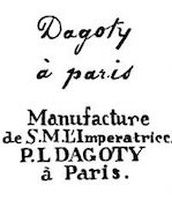Изготовитель Даготи Dagoty Мануфактура
Купить фарфор Даготи Dagoty Мануфактура (фарфор). Продажа фарфоровых изделий на art-picture.ru
- Вначале высокая цена | низкая цена
Изготовитель Даготи Dagoty Мануфактура (фарфор)

Эта мануфактура — одно из самых известных в России парижских фарфоровых предприятий первой четверти XIX века. Фамилия Даготи объединяет трех братьев: Пьера-Луиса, Жана-Батиста Этьена и Месидора. Самый известный из них —
Пьер-Луис (1771 —1840), сын художника-портретиста, служившего Марии-Антуанетте, и внук анатома Гутьера Даготи. Братья Даготи были учениками Дила и Герара на мануфактуре герцога Ангулемского, где они осваивали искусство изготовления фарфора. Кроме того, они занялись и торговлей. Будучи предпринимателями, братья Даготи попытались реализовать себя в производстве фарфора, обосновавшись в 1790 году в маленьком помещении на бульваре Пуассоньер. По этому адресу у Жана-Батиста Этьена Гутьера Даготи, художника по фарфору, были магазин и мастерская, где он занимался своим ремеслом со старшим братом Пьером. После смерти Жана-Батиста Пьер-Луис Даготи в 1804 году выкупил фабрику и магазин и быстро добился большого успеха. По производству «предприятие Даготи в 1807 году стояло впереди всех парижских мануфактур. На нем было занято от 100 до 120 рабочих». Когда пришел успех, владелец решил расширить предприятие и купить настоящую фабрику. Выбор пал на мануфактуру Роже в Монпарнасе на рю де Шеврез, которая была приобретена около 1815 года.
Пьер-Луи Dagoty родился в Париже в 1771 году, в семье художников и скульпторов. Его отец, Жан-Батист Андре Dagoty (его полное имя, Готье Dagoty), был одним из художников королевы Марии-Антуанетты.
Пьер-Луи Dagoty, с помощью своих братьев, Изидора и Этьена Жан-Батиста, с 1798 по 1800 год(даты их кончин) ,открыли небольшую мастерскую, которая специализировалась в живописи на тонком фарфоре. Очень быстро, их продукция завоевала хорошую репутацию. И в декабре 1804 года, сама императрица Жозефина , оказала им своё покровительство. Производство братьев Dagoty стало:« Manufacture de S.M. l'Impératrice, P.L. Dagoty à Paris » (de 1804 à 1814) "Производством Её Величества Императрицы, PL Dagoty в Париже" (с 1804 по 1814 г.)
Затем ,после падения Первой Империи-« Manufacture de S.A.R. Madame la Duchesse d'Angoulême. P.L. Dagoty » (de 1815 à 1820). «Фабрика S.A.R. Мадам Герцогиня д' Ангулем. P.L. Dagoty » (с 1815 по 1820)
Таким образом, маркировались все без исключения предметы(с тыльной стороны),и это было визитной карточкой Фабрики Dagoty,и защитой от подделок.
В 1810, Пьер-Луи, объединился с François Maurice Honoré,владельцем завода на rue de Chevreuse.
Ассоциация между Даготи и Франсуа Морисом Оноре, продолжалась с 1816 до 1819 год.
А в 1823 году, Пьер-Луи продал фабрику à Denuelle Dominique.Так появилась фабрика la Manufacture La Seynie, около 1900 года.
У фарфора Dagoty была особенность, а именно, техника, которая состояла в том, чтобы покрывать внутреннюю часть объектов (обычно чашек) густым золотым крытьём. А внешние пейзажи, были расписаны крайне богато, чередуя тёмные и светлые тона, блестящее и матовое золото. Эта особенность, делала фарфор Даготи, узнаваемым, среди других производителей. Он стал крайне востребован среди княжеских дворов, таких, как la Maison de Russie, la Maison de Savoie,а позже, и Столом американского президента Монро, который получил президентскую, условленную службу « в малиновом крыле » (в 1817).Этими экземплярами фарфора Даготи, могут и сейчас восхищаться посетители, он находятся в витринах Белого Дома.
В Париже, на бульваре Poissonnière,братья Dagoty открыли фешенебельный магазин, куда спешило все высшее общество того времени, за подарками ко Дню Рождения, или других событий. Иметь фарфор Dagoty, было признаком хорошего вкуса.
Другая особенность Дома Dagoty - исчерпывающий каталог (нарисованный от руки) всех моделей, которые были выполнены этой фабрикой. Полный экземпляр этого каталога сохранен в офисе чертежей музея декоративных искусств -musée des arts décoratifs de Paris.

